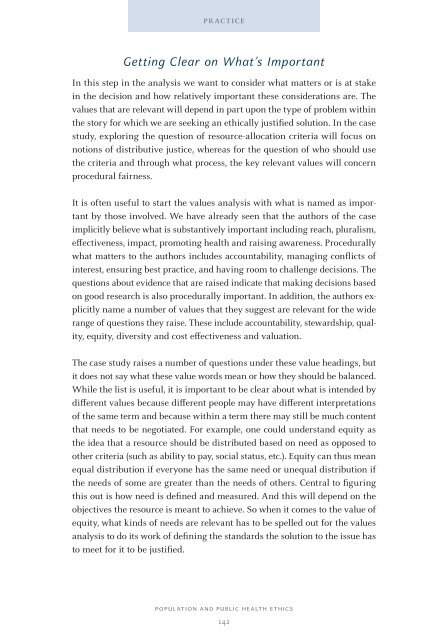PoPulationand Public HealtH etHics
PoPulationand Public HealtH etHics
PoPulationand Public HealtH etHics
You also want an ePaper? Increase the reach of your titles
YUMPU automatically turns print PDFs into web optimized ePapers that Google loves.
practice<br />
Getting Clear on What’s Important<br />
In this step in the analysis we want to consider what matters or is at stake<br />
in the decision and how relatively important these considerations are. The<br />
values that are relevant will depend in part upon the type of problem within<br />
the story for which we are seeking an ethically justified solution. In the case<br />
study, exploring the question of resource-allocation criteria will focus on<br />
notions of distributive justice, whereas for the question of who should use<br />
the criteria and through what process, the key relevant values will concern<br />
procedural fairness.<br />
It is often useful to start the values analysis with what is named as important<br />
by those involved. We have already seen that the authors of the case<br />
implicitly believe what is substantively important including reach, pluralism,<br />
effectiveness, impact, promoting health and raising awareness. Procedurally<br />
what matters to the authors includes accountability, managing conflicts of<br />
interest, ensuring best practice, and having room to challenge decisions. The<br />
questions about evidence that are raised indicate that making decisions based<br />
on good research is also procedurally important. In addition, the authors explicitly<br />
name a number of values that they suggest are relevant for the wide<br />
range of questions they raise. These include accountability, stewardship, quality,<br />
equity, diversity and cost effectiveness and valuation.<br />
The case study raises a number of questions under these value headings, but<br />
it does not say what these value words mean or how they should be balanced.<br />
While the list is useful, it is important to be clear about what is intended by<br />
different values because different people may have different interpretations<br />
of the same term and because within a term there may still be much content<br />
that needs to be negotiated. For example, one could understand equity as<br />
the idea that a resource should be distributed based on need as opposed to<br />
other criteria (such as ability to pay, social status, etc.). Equity can thus mean<br />
equal distribution if everyone has the same need or unequal distribution if<br />
the needs of some are greater than the needs of others. Central to figuring<br />
this out is how need is defined and measured. And this will depend on the<br />
objectives the resource is meant to achieve. So when it comes to the value of<br />
equity, what kinds of needs are relevant has to be spelled out for the values<br />
analysis to do its work of defining the standards the solution to the issue has<br />
to meet for it to be justified.<br />
PoPulation anD <strong>Public</strong> <strong>HealtH</strong> <strong>etHics</strong><br />
142
















